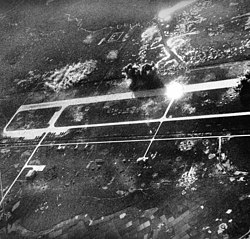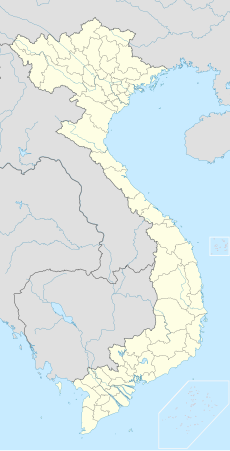Phúc Yên Air Base
| Phúc Yên Air Base | |
|---|---|
| Part of Vietnam People's Air Force | |
 Phúc Yên under attack in 1967 | |
| Type | Air Force Base |
| Site information | |
| Controlled by | |
| Site history | |
| Built | 1960s |
| In use | 1964-Present |
| Battles/wars | Vietnam War Action of 23 August 1967 |
Airfield information | |||||||||||||||
|---|---|---|---|---|---|---|---|---|---|---|---|---|---|---|---|
| Summary | |||||||||||||||
 | |||||||||||||||
| Runways | |||||||||||||||
| |||||||||||||||
Phúc Yên Air Base (also known as Noi Bai Air Base) is a Vietnam People's Air Force (VPAF) (Không quân Nhân dân Việt Nam) military airfield located immediately north of Noi Bai International Airport and approximately 30 kilometres (19 miles)* north of Hanoi.
History
Vietnam War
Phúc Yên was North Vietnam's first jet-capable airfield and on 6 August 1964 the first VPAF jet fighter unit, the 921st Fighter Regiment (known as the Red Star Squadron), arrived at Phúc Yên after training in the People's Republic of China (PRC), bringing 36 MiG-17 and MiG-19 fighters.[1]
In response to the attack on Bien Hoa Air Base on 1 November 1964 the Joint Chiefs of Staff (JCS) proposed a B-52 strike on Phúc Yên, but this was opposed by senior Johnson Administration officials.[2]
At the start of Operation Rolling Thunder in March 1965, U.S. aircraft were forbidden to go within a radius of 40 nautical miles of Hanoi, which included Phúc Yên, although these restrictions were gradually reduced as the campaign continued.[2]: 96
In May 1965 Il-28 bombers were identified at Phúc Yên, as these aircraft were capable of conducting airstrikes on South Vietnam the JCS again proposed a B-52 strike on Phúc Yên and nearby SA-2 sites, but once again approval was denied for fear that such an attack might provoke increased Soviet and PRC support for North Vietnam or even PRC intervention in the war.[2]: 143–4
By late March 1966 U.S. intelligence indicated that more than 60 MiG-15s and MiG-17s and 15 MiG-21s were based at Phúc Yên while crates containing an estimated 5 MiG-15s and 25 MiG-21s were also at the base.[2]: 241
In April 1966 the CIA concluded that a small number of MiG-21s had possibly deployed to Kép Air Base from Phúc Yên.[3]
On 24/5 October 1967 in response to increased VPAF fighter interceptions USAF, Navy and Marine aircraft attacked Phúc Yên for the first time.[1]: 156 Post-strike assessment indicated that nine MiGs had been destroyed on the ground and one in the air and that the runway was severely cratered.[4]
On 18 November 1967 a Combat Skyspot attack by 16 F-105s of the 388th Tactical Fighter Wing preceded by 4 F-105 Wild Weasels on Phúc Yên resulted in the loss of 2 Wild Weasels to MiGs and then some of the bombers to SAM sites that tracked the USAF jamming.
In early 1968 U.S. intelligence noted that Il-28 bombers had returned to Phúc Yên and three separate airstrikes were conducted against the base in mid-February. One Il-28 was believeed to have been damaged in the raid while two MiG-17s were shot down.[5]
Phúc Yên, Kép and Hoa Lac were targeted on the first night of Operation Linebacker II on 18 December 1972.
Postwar
In 1978 Noi Bai International Airport was established immediately south of the base to replace Gia Lam Airport as the main airport servicing Hanoi.
Current use
The VPAF 921st Fighter Regiment operating MiG-21s and Su-22M-4/UM-3K remains based at Phúc Yên.
References
- ^ a b Nichols, John (1987). On Yankee Station: The Naval Air War Over Vietnam. United States Naval Institute. p. 152. ISBN 978-0-87021-559-9.
- ^ a b c d VanStaaveren, Jacob (2002). Gradual failure: the air war over North Vietnam 1965-1966. Diane Publishing. p. 59. ISBN 9781428990180.
- ^ "Implications of the recent jet fighter clashes over North Vietnam" (PDF). Central Intelligence Agency. 1966. p. 5. Retrieved 4 January 2015.
- ^ Davies, Peter (2004). USAF F-4 Phantom II MiG Killers 1965-68. Osprey Publishing. p. 74. ISBN 9781841766560.
- ^ Thompson, Wayne (2003). To Hanoi and Back: The United States Air Force and North Vietnam 1966-1973. Government Printing Office. pp. 127–8.

